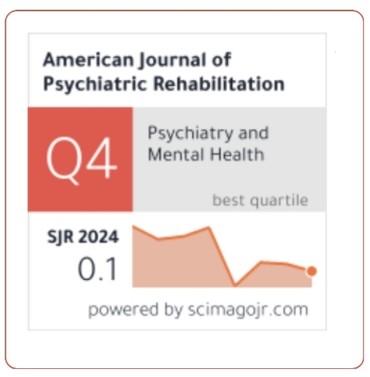A Comparative Study of Bipolar I and Bipolar II Disorder: Clinical Features and Treatment Outcomes
DOI:
https://doi.org/10.69980/ajpr.v28i5.682Keywords:
Bipolar Disorder, Psychiatric Rehabilitation, Psychosocial Interventions, Functional Recovery, Community Mental HealthAbstract
Bipolar I and Bipolar II disorders, though both situated within the bipolar spectrum, are distinguished by significant differences in clinical presentation, course of illness, and psychosocial consequences. Bipolar I is characterized by manic episodes, often requiring hospitalization, whereas Bipolar II is characterized by recurrent depressive episodes and hypomania, leading to persistent functional impairment and underdiagnosis. The study explores these clinical distinctions and evaluates their implications for psychiatric rehabilitation and recovery-oriented care. It examines pharmacological outcomes alongside evidence-based psychosocial interventions such as cognitive-behavioral therapy, interpersonal and social rhythm therapy, psychoeducation, and peer-led recovery programs. Individualized strategies are prioritized, and Bipolar I usually requires a more structured crisis intervention and functional reintegration plans. In contrast, Bipolar II responds better through long-term administration of psychotherapy and motivational encouragement. The role of community-based mental health services (containing assertive community treatment, supported employment, and transitional housing) is covered within the dynamics of gaining autonomy and a better quality of life. CHIME (Connectedness, Hope, Identity, Meaning, Empowerment) is introduced as a basis of the self-recovery model. At the systems level, it is noted that integrated care, workforce development/maturation, and policy alignment are crucial elements for achieving equity in accessibility and outcome monitoring. The research highlights the importance of subtype-sensitive individualized rehabilitation models that would not only be able to stabilize a patient in the clinical sense but would also allow people to successfully recover both on a long-term basis and in terms of functionality overall.
References
1. Aguglia, A., Giacomini, G., De Michiel, C. F., Garbarino, N., Lechiara, A., Magni, C., ... & Serafini, G. (2024). Characterization of bipolar disorder I and II: clinical features, comorbidities, and pharmacological pattern. Alpha Psychiatry, 25(4), 472.
2. Aliyu, T. A. (2024). Social Engagement and Self-Efficacy as Correlates of Social Adjustment of Individuals with Intellectual Disability (Master's thesis, Kwara State University (Nigeria)).
3. Alosaimi, F., Alateeq, D., AlHenaki, R., Hussain, S. B., Salamah, A. B., Al-Muhanna, A., & AlAngari, M. (2017). Advocacy and Patient Organizations. Bipolar Disorders, 19(1), 70-157.
4. Basco, M. R., & Rush, A. J. (2005). Cognitive-behavioral therapy for bipolar disorder. Guilford Press.
5. Becker, D. F., & Grilo, C. M. (2015). Comorbidity of mood and substance use disorders in patients with binge-eating disorder: Associations with personality disorder and eating disorder pathology. Journal of psychosomatic research, 79(2), 159-164.
6. Berk, M., Corrales, A., Trisno, R., Dodd, S., Yatham, L. N., Vieta, E., ... & Agustini, B. (2025). Bipolar II disorder: a state‐of‐the‐art review. World Psychiatry, 24(2), 175-189.
7. Bond, G. R., & Drake, R. E. (2015). The critical ingredients of assertive community treatment. World psychiatry: official journal of the World Psychiatric Association (WPA), 14(2), 240–242. https://doi.org/10.1002/wps.20234
8. Bora, E., Yücel, M., Pantelis, C., & Berk, M. (2011). Meta‐analytic review of neurocognition in bipolar II disorder. Acta Psychiatrica Scandinavica, 123(3), 165-174.
9. Bottai, T., Biloa-Tang, M., Christophe, S., Dupuy, C., Jacquesy, L., Kochman, F., ... & Azorin, J. M. (2010). Interpersonal and social rhythm therapy (IPSRT). L'encephale, 36, S206-17.
10. Calesella, F. (2024). COGNITIVE IMPAIRMENT IN MOOD DISORDERS: NEUROPSYCHOLOGY, MULTIMODAL BRAIN IMAGING, AND THE EFFECT OF NEUROINFLAMMATION.
11. Canacott, L., Moghaddam, N., & Tickle, A. (2019). Is the Wellness Recovery Action Plan (WRAP) efficacious for improving personal and clinical recovery outcomes? A systematic review and meta-analysis. Psychiatric rehabilitation journal, 42(4), 372–381. https://doi.org/10.1037/prj0000368
12. Canham, J. (2016). The development of an intervention to support job retention and return to work for individuals with a diagnosis of bipolar disorder (Doctoral dissertation, Cardiff University).
13. Carli, M., Weiss, F., Grenno, G., Ponzini, S., Kolachalam, S., Vaglini, F., ... & Scarselli, M. (2023). Pharmacological strategies for bipolar disorders in acute phases and chronic management with a special focus on lithium, valproic acid, and atypical antipsychotics. Current Neuropharmacology, 21(4), 935-950.
14. Corrigan, P. W., Mueser, K. T., Bond, G. R., Drake, R. E., & Solomon, P. (2012). Principles and practice of psychiatric rehabilitation: An empirical approach. Guilford Press.
15. Cunningham, P., McKenzie, K., & Taylor, E. F. (2006). The struggle to provide community-based care to low-income people with serious mental illnesses. Health Affairs, 25(3), 694-705.
16. Del Mar Bonnin, C., Montejo, L., Martinez-Aran, A., Solé, B., Comes, M., & Torrent, C. (2022). Psychosocial recovery-oriented treatments in bipolar disorders. In Recovery and Major Mental Disorders (pp. 173-197). Cham: Springer International Publishing.
17. DeRubeis, R. J., Zajecka, J., Shelton, R. C., Amsterdam, J. D., Fawcett, J., Xu, C., ... & Hollon, S. D. (2020). Prevention of recurrence after recovery from a major depressive episode with antidepressant medication alone or in combination with cognitive behavioral therapy: phase 2 of a 2-phase randomized clinical trial. JAMA psychiatry, 77(3), 237-245.
18. Dhanoa, T. (2018). Quality of life, functional outcomes, and depression: 3 years following the onset of bipolar disorder (Doctoral dissertation, University of British Columbia).
19. Elsayed, O. H., Ercis, M., Pahwa, M., & Singh, B. (2022). Treatment-resistant bipolar depression: therapeutic trends, challenges and future directions. Neuropsychiatric Disease and Treatment, 2927-2943.
20. Ernala, S.K., Seybolt, J., Yoo, D. W., Birnbaum, M. L., Kane, J. M., & Choudhury, M. (2022). The Reintegration Journey Following A Psychiatric Hospitalization: Examining the Role of Social Technologies. Proceedings of the ACM on human-computer interaction, 6(CSCW1), 122. https://doi.org/10.1145/3512969
21. Farr, J. (2021). Understanding the experience of mood change and early intervention for people diagnosed with bipolar disorder (Doctoral dissertation, Birkbeck, University of London).
22. Fletcher, K., & Murray, G. (2021). Towards tailored psychosocial intervention for BD-II: lived experience perspectives on current and future management options. Journal of Affective Disorders, 289, 110-116.
23. Gannon, J. M., & Eack, S. M. (2024). Psychosocial Treatment for Psychotic Disorders: Systems of Care and Empirically Supported Psychosocial Interventions. Schizophrenia and Related Disorders, 247.
24. Gkintoni, E., & Michou, E. (2024). Advancing neuropsychological rehabilitation in primary progressive aphasia based on principles of cognitive neuroscience: A scoping review and systematic analysis of the data. Brain Sciences, 14(12), 1234.
25. Goes, F. S. (2023). Diagnosis and management of bipolar disorders. BMJ, 381.
26. Hopper, E. K. (2017). The multimodal social ecological (MSE) approach: A trauma-informed framework for supporting trafficking survivors’ psychosocial health. Human trafficking is a Public Health Issue: A paradigm expansion in the United States (pp. 153-183). Cham: Springer International Publishing.
27. Jagfeld, G. S. J. (2023). Talking About Personal Recovery in Bipolar Disorder: Integrating Health Research, Natural Language Processing, and Corpus Linguistics to Analyse Peer Online Support Forum Posts. Lancaster University (United Kingdom).
28. Jagfeld, G., Lobban, F., Marshall, P., & Jones, S. H. (2021). Personal recovery in bipolar disorder: Systematic review and “best fit” framework synthesis of qualitative evidence–a POETIC adaptation of CHIME. Journal of Affective Disorders, 292, 375-385.
29. Kelly, B. (2025). The modern psychiatrist’s guide to contemporary practice: discussion, dissent, and debate in mental health care (p. 272). Taylor & Francis.
30. Kendler, K. S. (2017). The clinical features of mania and their representation in modern diagnostic criteria. Psychological Medicine, 47(6), 1013-1029.
31. Kessler, R. C., Bromet, E. J., de Jonge, P., Shahly, V., & Wilcox, M. (2017). The burden of depressive illness. Public health perspectives on depressive disorders. Baltimore: Johns Hopkins University Press, 40.
32. Kew, B. M., Monk, N. J., Conner, T. S., Frampton, C., Mulder, R. T., Porter, R. J., ... & Douglas, K. M. (2025). Symptom Overlap Between Depression and Borderline Personality Disorder: A Network Analysis. Personality and mental health, 19(2), e70019.
33. Kidd, S. A., McKenzie, K. J., & Virdee, G. (2014). Mental health reform at a systems level: widening the lens on recovery-oriented care. The Canadian Journal of Psychiatry, 59(5), 243-249.
34. Kirkbride, J. B., Anglin, D. M., Colman, I., Dykxhoorn, J., Jones, P. B., Patalay, P., ... & Griffiths, S. L. (2024). The social determinants of mental health and disorder: evidence, prevention and recommendations. World Psychiatry, 23(1), 58-90.
35. Korkmaz, Ş. Ü. K. R. Ü. Important Research of the Past Year in the Field of Mood Disorders: Studies on Treatment Options in Bipolar Disorder.
36. Krebs, C. E. (2018). The molecular signatures of bipolar disorder and lithium treatment. University of California, Los Angeles.
37. Krizhanovskyi, D. (2025). Pharmacological Management of Comorbid ADHD and Bipolar I Disorder in Adults: Evidence-Based Strategies for Stimulants, Mood Stabilizers, and Antipsychotics. Mood Stabilizers and Antipsychotics (May 22, 2025).
38. Lamsal, S. (2023). Nursing Care and management for patients with bipolar disorder in home care.
39. Lengvenytė, A. (2020). Computerized working memory training improves functioning in euthymic patients with bipolar disorder and cognitive complaints. In European psychiatry: Abstracts of the 28th European Congress of Psychiatry. (Vol. 63, No. S1, pp. 68-68). Cambridge University Press.
40. Levy, B., Tsoy, E., Brodt, M., Petrosyan, K., & Malloy, M. (2015). Stigma, social anxiety, and illness severity in bipolar disorder: Implications for treatment. Annals of Clinical Psychiatry, 27(1), 55-64.
41. Lukens, T. (2016). Relationship between creativity and bipolar disorder. Palo Alto University.
42. Macneil, C. A. (2009). Bipolar disorder in young people: a psychological intervention manual. Cambridge University Press.
43. McIntyre, R. S., Alda, M., Baldessarini, R. J., Bauer, M., Berk, M., Correll, C. U., ... & Maj, M. (2022). The clinical characterization of the adult patient with bipolar disorder is aimed at personalized management. World Psychiatry, 21(3), 364-387.
44. Melillo, A., Sansone, N., Allan, J., Gill, N., Herrman, H., Cano, G. M., ... & Galderisi, S. (2025). Recovery-oriented and trauma-informed care for people with mental disorders to promote human rights and quality of mental health care: a scoping review. BMC psychiatry, 25(1), 125.
45. Michalak, E. E., Yatham, L. N., Maxwell, V., Hale, S., & Lam, R. W. (2007). The impact of bipolar disorder upon work functioning: a qualitative analysis. Bipolar Disorders, 9(1‐2), 126-143.
46. Monferrer, M., García, A. S., Ricarte, J. J., Montes, M. J., Fernández-Caballero, A., & Fernández-Sotos, P. (2024). Dynamic virtual faces demonstrate deterioration in the recognition of facial emotion in bipolar disorder patients. Current Psychology, 43(17), 15113-15124.
47. Morton, E., Armstrong, H. L., Michalak, E. E., & Murray, G. (2024). Bipolar Disorder (BD). In Encyclopedia of Quality of Life and Well-Being Research (pp. 473-477). Cham: Springer International Publishing.
48. Morton, E., Murray, G., Michalak, E. E., Lam, R. W., Beaulieu, S., Sharma, V., ... & Yatham, L. N. (2018). Quality of life in bipolar disorder: towards a dynamic understanding. Psychological Medicine, 48(7), 1111-1118.
49. NUNEZ, A. (2024). Clinical correlates of emotional dysregulation in bipolar disorder spectrum: a case-control study.
50. Oliva, V., Fico, G., De Prisco, M., Gonda, X., Rosa, A. R., & Vieta, E. (2025). Bipolar disorders: an update on critical aspects. The Lancet Regional Health–Europe, 48.
51. Polcin D. L. (2016). Co-occurring Substance Abuse and Mental Health Problems among Homeless Persons: Suggestions for Research and Practice. Journal of social distress and the homeless, 25(1), 1–10. https://doi.org/10.1179/1573658X15Y.0000000004
52. Ratheesh, A., Hett, D., Ramain, J., Wong, E., Berk, L., Conus, P., ... & Marwaha, S. (2023). A systematic review of interventions in the early course of bipolar disorder I or II: a report of the International Society for Bipolar Disorders Taskforce on early intervention. International Journal of Bipolar Disorders, 11(1), 1.
53. Salmeron, A. (2015). Developing a peer-run support group to promote mental health and support services for the Bipolar Disorder population in Nicaragua. Mississippi College.
54. Schaffer, A., Isometsä, E. T., Azorin, J. M., Cassidy, F., Goldstein, T., Rihmer, Z., ... & Yatham, L. (2015). A review of factors associated with greater likelihood of suicide attempts and suicide deaths in bipolar disorder: Part II of a report of the International Society for Bipolar Disorders Task Force on Suicide in Bipolar Disorder. Australian & New Zealand Journal of Psychiatry, 49(11), 1006-1020.
55. Serafini, G., Gonda, X., Aguglia, A., Amerio, A., Santi, F., Pompili, M., & Amore, M. (2019). Bipolar subtypes and their clinical correlates in a sample of 391 bipolar individuals. Psychiatry research, 281, 112528.
56. Shannon, C., McCartan, C., Mulholland, C., & Davidson, G. (2023). A rapid review to inform the further development of mental health rehabilitation services in Northern Ireland.
57. TASHJIAN, A. B., KUNDERT, C., & CORRIGAN, P. (2022). Psychiatric Rehabilitation. The Professional Practice of Rehabilitation Counseling, 429.
58. Tyler, E. (2022). Developing a recovery-focused therapy for older people with bipolar disorder. Lancaster University (United Kingdom).
59. Van den Heuvel, S. C. G. H. (2021). Searching for order in disorder: Self-management education for persons with bipolar disorders and their informal caregivers (Doctoral dissertation, sl: sn).
60. Van Rheenen, T. E., Lewandowski, K. E., Bauer, I. E., Kapczinski, F., Miskowiak, K., Burdick, K. E., & Balanzá‐Martínez, V. (2020). Current understandings of the trajectory and emerging correlates of cognitive impairment in bipolar disorder: An overview of evidence. Bipolar disorders, 22(1), 13-27.
61. Wilson, S., Hicks, B. M., Foster, K. T., McGue, M., & Iacono, W. G. (2015). Age of onset and course of major depressive disorder: associations with psychosocial functioning outcomes in adulthood. Psychological medicine, 45(3), 505–514.
Downloads
Published
Issue
Section
License
Copyright (c) 2025 American Journal of Psychiatric Rehabilitation

This work is licensed under a Creative Commons Attribution 4.0 International License.
This is an Open Access article distributed under the terms of the Creative Commons Attribution 4.0 International License permitting all use, distribution, and reproduction in any medium, provided the work is properly cited.









